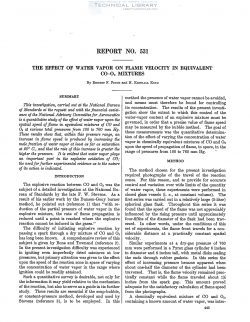naca-report-531

- Version
- 186 Downloads
- 666.08 KB File Size
- 1 File Count
- August 30, 2016 Create Date
- August 30, 2016 Last Updated
National Advisory Committee for Aeronautics, Report - The Effect of Water Vapor an Flame Velocity in Equivalent CO-O2 Mixtures

This investigation, carried out at the National Bureau
of Standards at the request and with the financial assist—
ance of the National Advisory Committee for Aeronautics
is a. quantitative study of the efl’ect of water vapor upon the
spatial speed of flame in equivalent mixtures of 00 and
0, at various total pressures from 100 to 760 mm Hg.
These results show that, within this pressure range, an
increase in fiame' speed is produced by increasing the
mole fraction of water vapor at least as far as saturation
at 26° 0., and that the rate of this increase is greater the
higher the pressure. It is evident that water vapor plays
an important part in the explosive oxidation of 00;
the need for further experimental evidence as to the nature
of its action is indicated.
The explosive reaction between 00 and 02 was the
subject of a detailed investigation at the National Bu—
reau of Standards by the late F. W. Stevens. As a
result of his earlier work by the Bunsen—Gouy burner
method, he pointed out (reference 1) that “with re—
duction of the partial pressure of water vapor in the
explosive mixture, the rate of flame propagation is
reduced until a point is reached where the explosive
reaction cannot be induced in the gases.”
The difficulty of initiating explosive reaction by
passing a spark through a dry mixture of CO and 02
has long been known. A comprehensive review of this
subject is given by Bone and Townend (reference 2).
In the present investigation difficulty was experienced
in igniting even imperfectly dried mixtures at low
pressures, but primary attention was given to the efl’ect
upon the speed of the reaction zone in space of varying
the concentration of water vapor in the range where
ignition could be readily attained.
Such a quantitative survey is desirable, not only for
the information it may yield relative to the mechanism
of the reaction, but also to serve as a guide in its further
study. These results are essential if the soap-bubble,
or constant-pressure method, developed and used by
Stevens (reference 3), is to be employed.
| File | Action |
|---|---|
| naca-report-531 The Effect of Water Vapor an Flame Velocity in Equivalent CO-O2 Mixtures.pdf | Download |

Comment On This Post